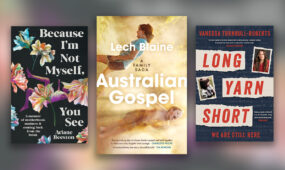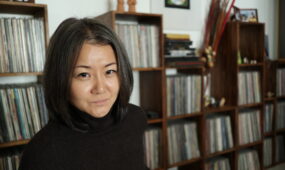Diary of a Bookseller: Confessions, cults and conspiracies
Books & Poetry
The confessions of another bookseller kick off Jo Case’s latest column after a month that has seen her take an accidental (reading) deep-dive into government secrets, cults, weird people and illicit drugs.

“So, are you the new Shaun Bythell?” asks my friend Giselle, who worked with me at a bookshop in Melbourne.
I don’t ask, Who’s that?
Giselle is 12 years younger than me, and culturally cutting-edge. Thanks to her, I was once fluent in millennial speak, and while we worked together, I could proudly explain terms like “thirst trap”, or the use of “hectic” as a compliment, to my baffled same-age friends. So, my immediate reaction to Giselle’s comment on my Facebook post is to not reveal how out of touch I am. I imagine Shaun Bythell is a new musical act, or an actor on a Netflix show I haven’t heard of yet.
But actually, it’s a bit more embarrassing than that.
Shaun Bythell, a quick Google search reveals, is the owner of Scotland’s second-largest second-hand bookshop, and author of the bestselling Diary of a Bookseller, a diary of a year in the shop, featuring his staff and regular customers as recurrent characters, alongside countless pop-ins, most of them asking annoying questions or telling him they love the shop, but buy most of their books online. I’ve shelved the book a million times, I’ve sold it, but I’ve never read it.
 Haha, I type to Giselle. Oops, I never thought of that when I picked the name for my column.
Haha, I type to Giselle. Oops, I never thought of that when I picked the name for my column.
The following week, unpacking new releases in the shop, I unearth Confessions of a Bookseller (Profile, October, $29.99): the sequel.
“Have you read this?” I ask Jason.
“Yeah,” he says. He read the first one. “He’s so rude to his customers!” He sounds a little awed. I mentally mark this one down as my Christmas pick for myself. Flicking through it at the biography shelf, before returning to the towering stack of boxes by the counter, it looks like the perfect pick for fans of Black Books (Bythell has a definite Bernard Black edge, though he’s more business savvy), booksellers (how many customers over the years have told us all that they love their Kindle, or buy their books online?) and really, anyone who likes to read about books and the people who love them.
This past month, I’ve been on a bit of an accidental (reading) deep-dive into government secrets, cults, weird people and illicit drugs. It all started when I was dusting the history shelves during a Saturday shift and read the back cover of Chaos: Charles Manson, the CIA and the Secret History of the Sixties (by Tom O’Neill with Dan Piepenbring, William Heinemann, July, $35).
I have a weird relationship with the Manson story: for most of my life, I’ve avoided any books or other pop-culture artefacts on the subject. It seemed tacky and lurid to be interested in it. Then, a couple of years ago, I listened to Karina Longworth’s incredible 12-part series Charles Manson’s Hollywood, a season of the Hollywood history podcast You Must Remember This. The series examined Manson as a product of his time, intricately entwined with the Californian hippy scene and deeply embedded in pockets of the entertainment industry, who’d spent time living with Beach Boy Brian Wilson and was friends with Doris Day’s son Terry Melcher, who lived at the Tate-Polanski house before the couple moved in, and had promised Charles Manson a recording contract, then welched on it.
 Chaos began life as a 5000-word commissioned retrospective on the echoes of the Manson murders in Hollywood, with a three-month deadline for a movie magazine. Journalist Tom O’Neill started off with a friendly relationship with Vincent Bugliosi, prosecutor of the Manson case and author of Helter Skelter, the bestselling book about the case (and bestselling true crime book of all time). But his digging uncovered evidence of a compromised case (not suggesting Manson didn’t do it, but that the prosecution’s story was full of holes and fabrications), multiple cover-ups for various law enforcement errors and missteps, and a seriously disturbing history of law-breaking and violence by Bugliosi (including beating his pregnant mistress to induce a miscarriage, then trying to cover it up).
Chaos began life as a 5000-word commissioned retrospective on the echoes of the Manson murders in Hollywood, with a three-month deadline for a movie magazine. Journalist Tom O’Neill started off with a friendly relationship with Vincent Bugliosi, prosecutor of the Manson case and author of Helter Skelter, the bestselling book about the case (and bestselling true crime book of all time). But his digging uncovered evidence of a compromised case (not suggesting Manson didn’t do it, but that the prosecution’s story was full of holes and fabrications), multiple cover-ups for various law enforcement errors and missteps, and a seriously disturbing history of law-breaking and violence by Bugliosi (including beating his pregnant mistress to induce a miscarriage, then trying to cover it up).
That was just the beginning of O’Neill’s journey, which unspooled into 20 years down the rabbit hole: there are also questions about Manson’s weirdly close relationship with the parole officer (and LSD researcher) who kept him out of jail so long, probable CIA involvement, and (really!) a link to the Kennedy assassination. It all sounds insane, but O’Neill presents it as soberly credible; he’s unearthed never-seen LAPD, FBI and CIA documents, and has been threatened by key players. And he doesn’t make any definitive pronouncements, but simply presents what he’s learned and connects it as best he can, always based on evidence. It’s an absolutely engrossing and convincing read.
 Louis Theroux has spent most of his working life exploring weird worlds, from his first segment for Michael Moore’s TV Nation, cross-referencing the predictions of various apocalyptic groups, to his Weird Weekends BBC series, where he embedded himself on porn sets, with backwoods survivalists, with Klansmen and neo-Nazis, and with professional wrestlers – and now, one-off specials and movies, like My Scientology Movie. His new autobiography, Gotta Get Theroux This: My Life and Strange Times in Television (Macmillan, $32.99) is a really interesting behind-the-scenes look at his shows, but is also fascinating in the way it traces his career journey, including early stints on a regional American newspaper and as an intern at Graydon Carter’s iconic Spy magazine. As a Theroux fan (and a bit of a fan of good media memoirs), I enjoyed this one.
Louis Theroux has spent most of his working life exploring weird worlds, from his first segment for Michael Moore’s TV Nation, cross-referencing the predictions of various apocalyptic groups, to his Weird Weekends BBC series, where he embedded himself on porn sets, with backwoods survivalists, with Klansmen and neo-Nazis, and with professional wrestlers – and now, one-off specials and movies, like My Scientology Movie. His new autobiography, Gotta Get Theroux This: My Life and Strange Times in Television (Macmillan, $32.99) is a really interesting behind-the-scenes look at his shows, but is also fascinating in the way it traces his career journey, including early stints on a regional American newspaper and as an intern at Graydon Carter’s iconic Spy magazine. As a Theroux fan (and a bit of a fan of good media memoirs), I enjoyed this one.
And it’s my bookseller duty to tell you, while I’m here, that fans of Louis’s dad, master travel writer Paul Theroux, will be happy this Christmas season, as he’s just published a new travel narrative, On the Plain of Snakes: A Mexican Road Trip (Penguin, October, $35).
“Are you a conspiracy theorist now?” asked my husband, as I regaled him with facts I’d learned from reading Fentanyl, Inc: How Rogue Chemists are creating the Deadliest Wave of the Opioid Epidemic (Ben Westhoff, Scribe, October, $35).
“It’s not a conspiracy if it’s real,” I said, probably confirming it for him.
I first heard of this book when a customer came into the shop telling me about the author’s ABC Radio National interview with Phillip Adams, and how he’d infiltrated a Chinese chemical factory that manufactured fentanyl for export to America, becoming the first journalist to do so. I love a good immersive journalism book, and read a couple on the opioid epidemic and America’s drug wars last year, so I hunted down a copy for myself. And I discovered a world I had no idea existed.
 Synthetic drugs like fentanyl (which is 50 times more potent than heroin) are taking over in popularity from popular illicit drugs like cocaine, heroin, LSD and MDMA, writes Ben Westhoff. Not because they’re better, but because they’re more efficient and effective to traffic. And the drug dealers of today are not what we think we know, either: rather than hanging out on street corners, they’re more likely to be operating via the Dark Web, sending their product through the mail.
Synthetic drugs like fentanyl (which is 50 times more potent than heroin) are taking over in popularity from popular illicit drugs like cocaine, heroin, LSD and MDMA, writes Ben Westhoff. Not because they’re better, but because they’re more efficient and effective to traffic. And the drug dealers of today are not what we think we know, either: rather than hanging out on street corners, they’re more likely to be operating via the Dark Web, sending their product through the mail.
China is crucial to the international drug trade, producing and selling precursors to chemicals like fentanyl in legitimate factories, staffed by telemarketers, many gaining from government incentives that reward their productivity. What’s truly scary is that the results of this are a flood of unreliable drugs, many manufactured to mimic the effects of popular drugs, that are resulting in spiking drug fatalities. This intriguing and terrifying book shows how prohibition has combined with technology and capitalism gone mad to create today’s drug crisis. It’s a potent argument that the War on Drugs has failed, and that we need a new gameplan.
And I’m rounding out my reading month with an immersive pleasure that has nothing to do with conspiracies or weirdness, and everything to do with ordinary life, rendered extraordinarily, by one of my very favourite writers. It’s a long dreamed-of experience: diving into the diaries of Helen Garner. Yellow Notebook: Diaries Volume 1, 1978–1987 (Text, November, $29.99) brings together fragments of Garner’s famous diaries, chronologically collected and only edited (Garner promises) for grammar and punctuation.
We’re invited into the brain of a great writer at the start of her career: doubting herself, honing and analysing her craft, taking pleasure in the moments where it all comes together and works, feeling belittled and overlooked, winning (and not winning) prizes and worrying over what to wear to the ceremonies.
 1979: “I’m writing three sentences a day. Wretched, ill-tempered, nervous, unbearable. Maybe I’m a one-book woman.”
1979: “I’m writing three sentences a day. Wretched, ill-tempered, nervous, unbearable. Maybe I’m a one-book woman.”
1981: “About writing: meaning is in the smallest event. It doesn’t have to be put there: only revealed.”
1984: “Is this ‘the artist’s fate? Always to be loved less than I need, or somehow to repel love, or what is seen as the myth or dream of our society as normal marital love? I feel I’m reaching my strength, in my work, but there’s a corresponding falling-away … it’s terribly sad.”
I can’t stop taking notes as I read, which means my progress is slow. It’s not just about being a writer (and the sort of person who becomes a writer), though. It’s also an insight into how Helen is and becomes herself – a growing attraction to spiritual belief and Christianity, despite herself, elucidated through her friendship with a writer who is probably Tim Winton; a fascination with the legal process and a first stint sitting in on court cases, long before her celebrated courtroom books (Joe Cinque’s Consolation, This House of Grief); her famous attention to domestic detail that speaks volumes; her beautiful relationship with daughter Alice. And there is heartbreak, raw truth and surprising beauty in how she records dealing with the end of a marriage (her second), in her early forties.

Get InReview in your inbox – free each Saturday. Local arts and culture – covered.
Thanks for signing up to the InReview newsletter.
I love this book so much that I forgot to hand a customer her change while I was selling it to her this week, and had to unlock the register to give it to her. She’d just told me that she and two friends were, by arrangement, buying this book to give to each other, and would each write a special message in it.
“That’s how much Helen means to us,” she said.
“I am so sorry,” I said, putting the notes in her hand. “I was talking too much.”
“Oh, no,” she said. “So was I. It’s that kind of book.”
Jo Case is a bookseller at Imprints on Hindley Street. Read her previous Diary of a Bookseller columns here.
Support local arts journalism
Your support will help us continue the important work of InReview in publishing free professional journalism that celebrates, interrogates and amplifies arts and culture in South Australia.
Donate Here





